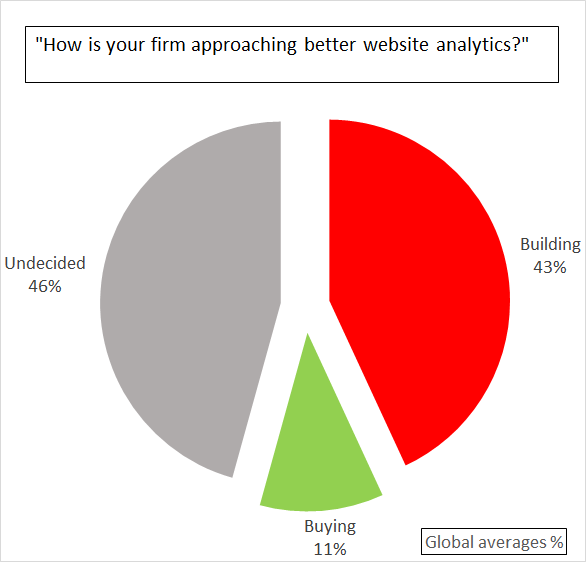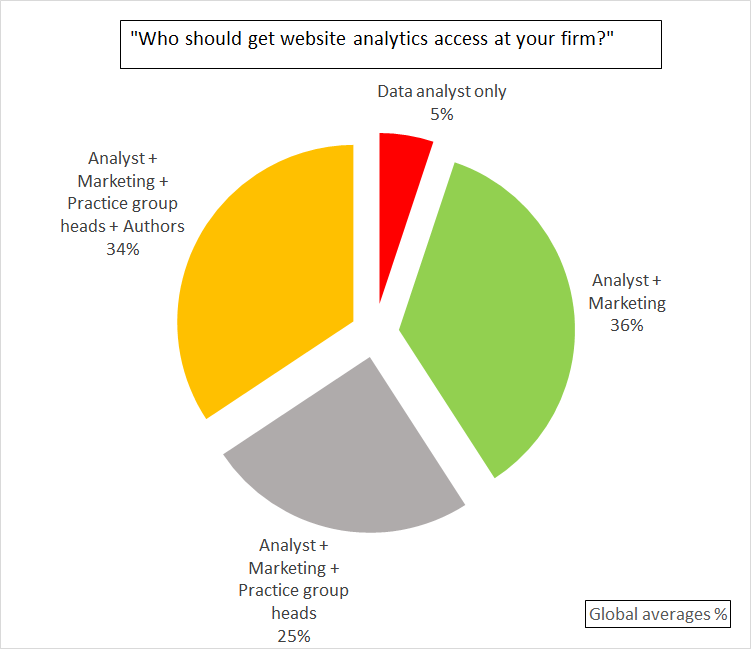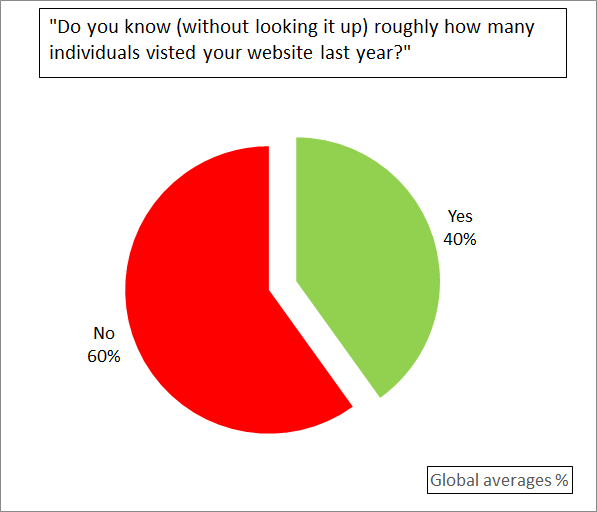Executive summary
Professional services firms’ views about the usefulness of website analytics are changing in our survey data
- firms’ fee-earners are aware that LinkedIn or Google make money by analysing what people are doing on their websites but there was less recognition that the same benefits can accrue to professional services firms: that your website analytics can tell you more about your market than any other single source of information. Now however, firms are becoming increasingly aware that their website’s analytics is the story of their market and not just the website itself.
- the majority of professional services firms polled were already working on website analytics projects with 54% building or buying website analytics solutions.
- they also believed access to web analytics should broaden across the firm. After being shown a reporting example built specifically for law firms, 59% of respondents thought it should be available to the broader marketing team and practice group heads, with more than a third of respondents wanting article authors to get direct access as well.
Some obstacles to effective website analytics in professional services firms remained
- lack of awareness of the size of the opportunity with 60% of respondents not able to roughly identify their own website’s visitor numbers (tens of thousands of visitors in even small firms)
- a tendency for some fee-earners to see the website as solely an electronic brochure – versus as a market research tool
- lack of understanding of the specific opportunities: for example that website analytics can de-anonymise companies visiting your website or give you advance visibility of each individual fee-earner’s business development pipeline
- lack of inhouse website analytics skills or knowledge of turnkey solutions such as Magnifirm’s
Survey data from professional services firms in North America, Australia and Asia
In the more virtual year of 2020 we polled over 214 staff in professional services firms in North American, Asian and Australian webinars about how they were approaching their firm’s website analytics.
We ran webinars on Using Google Analytics in professional services firms for the Australasian Legal Practice Management Association, ICON, the association for marketers in professional services firms, and for Mondaq the legal article syndicator (see the links at the end of this paper to view full webinars for members/subscribers).
The majority of poll respondents were law firms, followed by accountancy firms and engineering / consultancies.
In addition we worked on a record number of analytics projects last year.
1. Why are professional services firms getting increasingly interested in their website analytics?
a) Firms’ largest source of objective market information is their website analytics
Although stakeholders in professional services firms aren’t always aware of this (see poll results below) even small firms see tens of thousands of visitors a year, with large global firms seeing millions. After 20 years of a web presence and writing articles, most firms’ websites’ analytics are simply their largest source of data about what their market is interested in.
| Annual visitor numbers | Individuals visiting annually | Articles written annually |
| Smaller firms | 20,000+ | 10+ |
| Medium firms | 60,000+ | 40+ |
| Bigger national firms | 200,000+ | 100+ |
| Global firms | 1m+ | 300+ |
Whilst each fee-earner has differing opinions about what is happening in the market (even more so in the broad tent of general practice firms) website data is more objective and hence helpful in aligning stakeholders in firms. ‘Trust me I’m your marketing manager’ is not always the most effective argument either.
b) Business development can be done using website analytics
It’s possible to tag hyperlinks in tender docs so they identify prospects by name clicking on them, and store that in Google Analytics. So for business development purposes you can monitor their level of interest and re-approach prospects at the right time.
It’s even possible to generally de-anonymise companies visiting your website who you’ve had no contact with, and see named organisations looking at your individual fee earners, practice groups and publications.
c) Understand individual fee earners better using website analytics
You can actually track each call or email to each individual fee earner and trace that back through your website, as well as differentiate each fee-earner’s appeal for existing prospects or clients versus new prospects. You can also identify fee-earners that most need help or conversely who are good models for younger fee-earners.
d) Measure market strategy better
Break down client interest in individual practice groups by region or individual city; do the same for fee-earners or publications and view trends to understand growing and shrinking markets (‘manage better by measuring better’).
e) Digital presence will continue be more important than it was pre-Covid
Even in a post-Covid world of say 2023 new remote working habits will persist for cost, employee satisfaction and efficiency reasons.
Tools like Zoom, GoToMeeting and Microsoft Teams aren’t going away and organisations will need to continue to compare the return on exhibitions, conferences and other business travel options versus digital activities.
2. How are professional services firms broadly approaching website analytics?
More than half of firms polled in the 2020 webinars across North America, Asia and Australia are actively building or buying a website analytics solution with the rest still undecided about their approach (we discuss some buy vs build considerations below).

Even for those that are Undecided on the firm’s approach it’s worth noting that they are clearly interested enough to turn up to seminars on Google Analytics.
3. What groups in professional services firms should directly use website analytics data?
Logically, different groups in professional services firms bring varying insights to market data, and organisations benefit more from the data being shared versus sitting in a silo.
However the answer to this poll question about who in firms should have access differs widely depending on what analytics examples you show poll respondents first.
For example if you show people an analytics example like the one below, a ‘data belch’ that’s not easy to understand, nor structured for professional services firms, most people see less utility in analytics for your average practice group head, authors or even your professional services firm’s marketing department.
So before asking the question “Who should get website analytics access at your firm” we showed webinar attendees the following example of website analytics for a law firm:-
After being shown this example the majority of respondents thought analytics access should be provided well beyond the marketing team: to practice group heads and with about a third of respondents wanting authors to have direct access to analytics as well as the practice group heads:

North American firms are keenest to see analytics data most widely available across the firm, with 53% wanting it available to marketing and practice group heads and authors.
Apart from the fact that these groups get value from different elements of the market data, timely access is important, particularly for business development purposes if you can see named companies.
As one general manager put it “in the old days when a partner wanted billing information they would request it from the accounts department: now they can instantly call it up.”
4. What are the obstacles to effective website analytics in professional services firms from stakeholders?
a) Perceptions of the role of the website
If you ask partners in law firms or accountancy firms what they consider to be the main functions of their website, many will still refer to it being an online brochure with the afterthought that there is some phonebook functionality so prospects and clients can find fee-earners’ contact details.
There’s less recognition that every time a client or prospect interacts with your website your analytics is looking over the shoulder of each individual(in nearly all professional services firms via Google Analytics). And even if there is recognition of the two-way nature of information exchange when someone visits your site, analytics is often seen mainly as ‘a way of optimising our website’.
Although stakeholders do understand the business models for Facebook or Google work by monetizing information about audiences, they don’t necessarily realize that their own website’s analytics can also tell them far more about the market in which they operate than about the website itself.
Nor do they realize that the website’s analytics (with appropriate configuration) is capable of granular tracking of high value activities like when each individual fee-earner is contacted, or that website analytics can fulfil lead generation functions like revealing named companies anonymously visiting your service pages or fee-earner profiles.
b) Lack of awareness of the sheer size of the website analytics data set
If you told a partner in your firm that there’s no need to check-in with your largest client over the course of the year she or he would likely disagree.
Yet firms may neglect their largest source of market data, their website’s analytics.
One reason for this neglect is just confusion about website metrics.
Pageviews and session counts, while they produce large gross numbers, are not particularly meaningful or helpful as a top level metric. Even more helpful metrics like Unique Visitors (aka ‘Users’ in Google Analytics) should probably come with an explanation like ‘Users are individuals who visit one or more times over the course of the year only counted once.’
Typically stakeholders just don’t know this key Unique Visitor number, a key indicator of a firm’s footprint in the market. In our polling the majority of webinar attendees didn’t know their website’s rough visitor numbers.
Remember, these were people who had actively chosen to attend a webinar on Google Analytics – if they didn’t know how many visitors their website saw what does that imply about other stakeholders in professional services firms?
The highest awareness of visitor numbers was for professional services firms in North America (53% knew), followed by Australia (39%), followed by Asia (28%).
c) Skillset availability
Google Analytics, which has to work for ecommerce websites selling baby food along with professional services firms’ websites, is lowest common denominator. It’s more a tracking and reporting framework – a bit like Excel only becomes useful when you build a financial model corresponding to your firm’s commercial imperatives and metrics.
To build friendly and useful website analytics reporting, professional services firms really need to:
- add additional data to default GA metrics such as high value activities or push in names of companies visiting your firm and ideally make small website tweaks too
- build reporting structured specifically for professional services firms (which are not ecommerce companies) and learn one of a number of platforms designed to facilitate visual reporting
- be knowledgeable about the pros and cons of individual Google Analytics metrics in different situations (of which there are dozens), and implement appropriate data hygiene measures (garbage in = garbage out)
Both the platform and tracking need to be updated and staff succession issues managed as your website and Google Analytics itself changes over time – a rule of thumb in software projects being that 80% of costs are maintenance related. And some coding is required – with javascript and regex near the top the list of skills and a data analyst’s salary sitting at around $78k USD pa.
d) Turnkey SAAS solutions for website analytics for professional services firms
Because there’s lower awareness of both the opportunities and skillsets required for effective website analytics, buy versus build business case analysis isn’t always done properly for website analytics projects. And often firms simply won’t be aware that website analytics software-as-a-service solutions like Magnifirm’s exist.
This leads to an outcome like the early 90s when many law firms were building their own wordprocessing integrations for Microsoft Word or WordPerfect (now replaced by vendor-supplied document management systems).
5. Options to learn more
a) Get a free analytics reporting template built for your own website
Drop us an email with your website address or call us and we’ll build a reporting template specifically for your own website at no charge (we don’t need access to the data).
We’ll do a quick walkthrough with you of what it can tell you about your market and fee-earners, and you can either use it to scope building it yourself, or simply try out our low cost monthly subscription.
b) Watch one of the seminars
- ALPMA members can go to the continuing education section of their website here for the webinar
- If you are an ICON member the ‘Using Google Analytics in professional services firms’ webinar is here
- If you are a Mondaq subscriber you can find the webinar on using Google Analytics in law firms here
Photo by Señor Codo 







